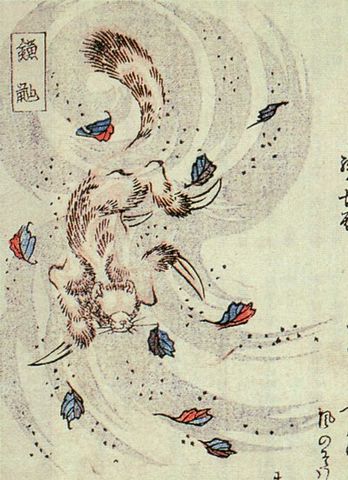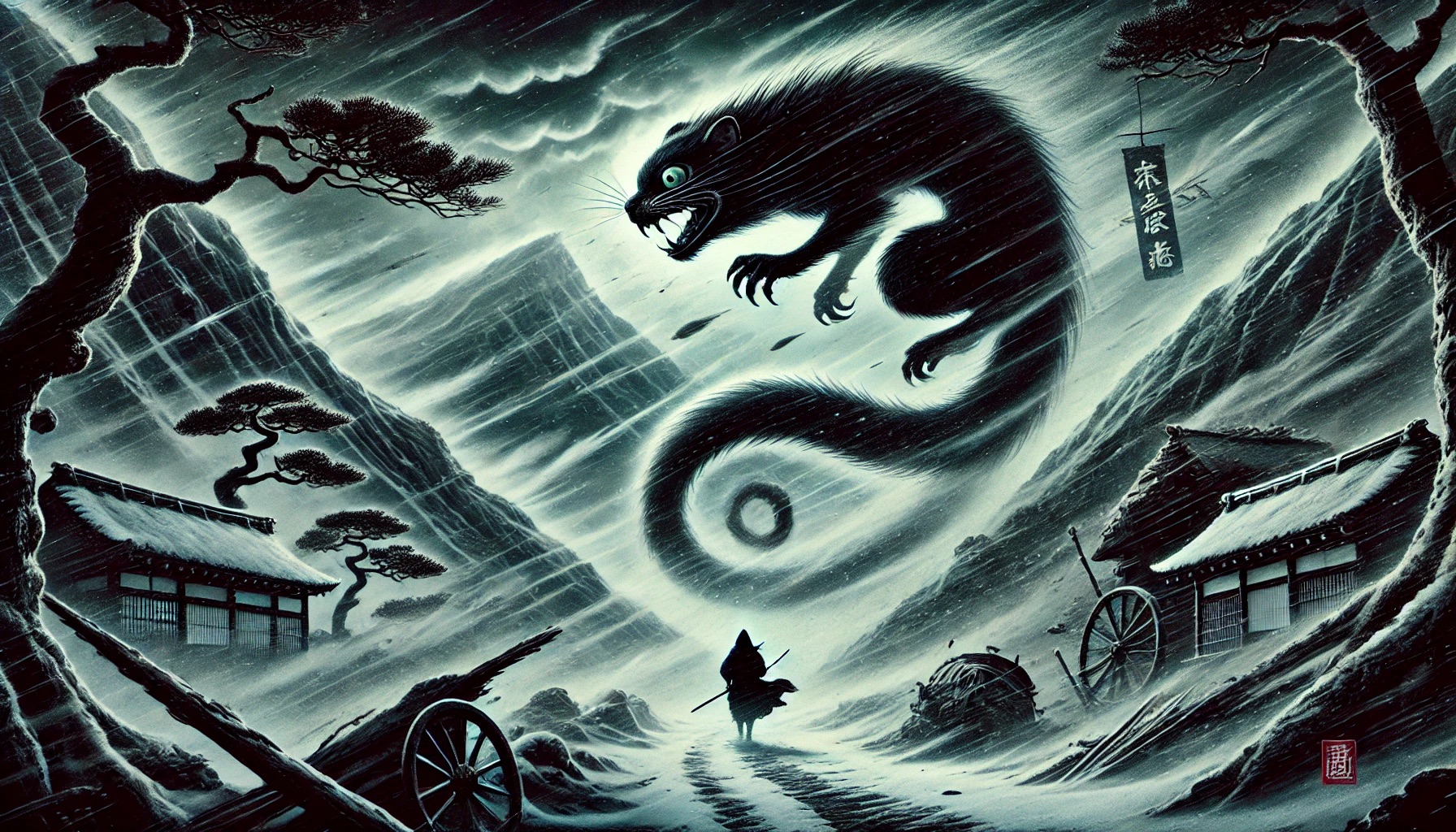Urban Legends from Japan – Strange Tales, Mysterious Encounters, and Modern Myths
Kamaitachi: The Sickle-Weasel Yokai That Slashes People in Whirlwinds

Imagine walking outside on a windy day, only to suddenly discover a sharp, clean cut on your skin, as if from a razor. There was no pain, no blood, just a mysterious wound that appeared from nowhere. In Japan, for centuries, the blame for such an event has been placed on the Kamaitachi—a terrifying, unseen monster that rides the whirlwinds. But is this yokai real, a natural phenomenon, or something else entirely?
The Invisible Attack of the Sickle-Weasel
The Kamaitachi (often written as 鎌鼬, meaning “sickle weasel”) is a legendary creature from Japanese folklore, most famously associated with snowy, mountainous regions. The classic version of the legend, primarily from the Hida and Mino regions, describes the Kamaitachi as a trio of weasel-like beings working in perfect, terrifying harmony:
・The First Weasel knocks the victim down.
・The Second Weasel slices their flesh with razor-sharp claws.
・The Third Weasel instantly applies a magical salve or medicine to the wound, which stops the bleeding and numbs the pain.
This entire sequence happens so quickly that the victim is often completely unaware they have been cut until much later. The lack of initial pain and blood is the creature’s calling card.
However, not all legends depict this three-part attack. In an 1850 collection of strange tales, the Sōzan Chomon Kishū, the wounds are described as initially painless but gradually becoming excruciating, sometimes cutting down to the bone or even causing death. Another variation from Aichi Prefecture describes a vampiric version of the creature, a blood-sucking weasel known as an Izuna, which was said to be the escaped familiar of a negligent sorcerer.
Debunking the Myth: From Vacuums to Chapped Skin
For centuries, people have tried to find a rational explanation for the “Kamaitachi phenomenon.” The leading scientific theory for many years was the “vacuum theory.” This hypothesis suggested that a whirlwind could create a temporary, localized vacuum at its center. When this vacuum pocket touched human skin, the rapid change in pressure would supposedly be enough to tear the flesh.
However, this theory has been largely debunked in recent years. Scientists now argue that any pressure difference created by a whirlwind would be too brief and too weak to cause such clean cuts. Furthermore, the phenomenon has only ever been reported on living flesh, never on inanimate objects like clothing or wood.
So what is the current scientific explanation? The most likely culprit, especially in the cold, dry regions where sightings are most common, is severe skin chapping or cracking (akagire). A sudden drop in temperature and humidity can cause the skin, particularly on exposed areas, to split open, creating deep, clean, and often initially painless cuts that can later become very painful. Another theory suggests that strong winds could be carrying small, sharp objects like pebbles or hardened leaves, which could act like tiny razors on exposed skin. It’s plausible that all these different natural phenomena have been collectively labeled over the centuries as the work of the Kamaitachi.

A Mystery That Endures
Despite these logical explanations, the legend of the Kamaitachi persists. The image of an invisible, sickle-wielding weasel riding the wind is too powerful, too viscerally terrifying to be dismissed as mere chapped skin. It speaks to a primal fear of the unseen, of the sudden, inexplicable harm that nature can inflict.
The name itself holds a clue to its enduring mystery. While it’s often written with the character for “weasel” (鼬), an older spelling is “構太刀,” meaning “poised long-sword.” This suggests the phenomenon was not always seen as an animal, but as an attack by a “blade of the gods” or a spiritual entity.
So, the next time you feel a sudden sting on a windy day, check your skin. It might just be the cold. Or, you might have just had a close encounter with one of Japan’s most mysterious and elusive yokai.
※ Unauthorized reproduction, video creation, and uploading of this article's content to YouTube, blogs, or other platforms is strictly prohibited.
Related Articles
Popular Series
This is the page for Kamaitachi: The Sickle-Weasel Yokai That Slashes People in Whirlwinds. Find the latest news about Folklore, Yokai and more on TOCANA - the paranormal news media that stimulates your curiosity
Urban Legends Latest Articles
The Definitive Guide to Japan's Scariest Urban Legends: From Kuchisake-Onna to Kisaragi Station
2025.10.20 23:00 Urban LegendsKunekune: The Definitive Guide to Japan's Terrifying, Twisting Field Monster
2025.10.19 23:00 Urban LegendsNNN Special Broadcast: The Definitive Guide to Japan's Lost, Lethal TV Broadcast
2025.10.14 23:00 Urban Legends


